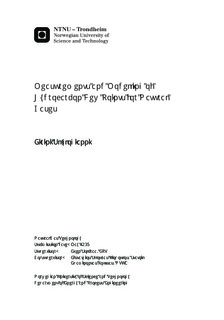| dc.description.abstract | The knowledge of the hydrocarbon dew point (HCDP) is of great importance for the oil and gas industry as it is one of the gas quality specifications used for ensuring safe transport of natural gas. Avoiding hydrocarbon condensation is crucial as the presence of liquids in the pipelines increases the pressure drop and introduces operational problems in pipelines designed for single phase transportation. Thus, accurate measurement and prediction of hydrocarbon dew points are of great importance to obtain a safe and effective utilization of the natural gas pipelines.At the laboratory facilities of Statoil in Trondheim a new rig (GERG rig) for measuring hydrocarbon dew points for natural gases is available. Hydrocarbon dew points were measured in order to study the effect of various factors on the accuracy of the HCDP measurement and, therefore, perform the qualification of the GERG rig. Hydrocarbon dew points are usually predicted using thermodynamic models, such as traditional cubic equations of state, like Soave-Redlich-Kwong (SRK). Previous studies have pointed out that classic EoS are not able to correctly represent the dew point line for natural gases, while more advanced models, such as the UMR-PRU, which is the Universal Mixing Rule combined with Peng Robinson Eos and UNIFAC, give significantly improved predictions.In this diploma thesis, hydrocarbon dew point measurements have been performed for two synthetic gases and one real gas. Several experiments have been conducted in order to study the effect of the volume of the sample gas, the chamber?s temperature and the sample conditioning. The results show that there is no volume effect or effect of the sample conditioning. On the other hand, a 10°C difference of the chamber?s temperature from 35 to 45 °C has an effect of approximately 0.9 °C on the measured dew points. Given the fact that there is adsorption of heavy hydrocarbons inside the rig, which is a known challenge in HCDP measurements, the effect is more pronounced in gases consisting of heavier compounds, as in the case of the real gas.The dew point experimental data are used to evaluate the reliability of three thermodynamic models: SRK, PC-SAFT and UMR-PRU.All three models studied appear to yield satisfactory results. SRK and PC-SAFT?s predictions are very similar at low pressures up to the cricondentherm temperature, while SRK is better than PC-SAFT at higher pressures. Both these models describe better the experimental data obtained from the synthetic gases than UMR-PRU, except from the high pressures, and especially the cricondenbar pressure, where UMR-PRU gives the best results. Furthermore, the real gas? dew point curve is adequately predicted by UMR-PRU, which yields the best predictions than the other two models. Finally, an uncertainty analysis is performed which further confirms the reliability of the UMR-PRU model. | nb_NO |

